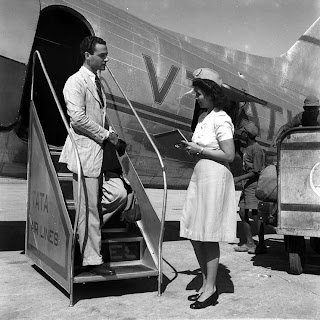 |
| The Indian Night Air Mail Service network. |
In the late 1940s the rail and road infrastructure of India was already inadequate for the task of linking the newly-independent nation. While the sub-continent had a fairly dense rail network as a legacy of its time under the British crown, its reliability was sketchy at best and with the growing demands of the Indian commercial sector for better mail service, on 30 January 1949 the government inaugurated the Indian Night Air Mail Service- the world's first overnight air mail service- keeping in mind, that FedEx as Federal Express launched its overnight package delivery service in Memphis, Tennessee, in 1973. Since space was a premium at daytime flights, it was decided that air mail would move at night and this had the added advantage of making overnight delivery possible in what may very well be also the world's first example if not one of the earliest examples of a hub-and-spoke operation. Under this system, the four main cities of India also happened to form each of the four corners of a diamond- New Delhi to the north, Bombay to the west, Calcutta to the east, and Madras to the south. Connecting these cities was a central location at the city of Nagpur in central India.
The system was quite simple- letters postmarked for overnight air mail were delivered to each of the corners of the NAM system in the evening and loaded on aircraft. These aircraft, all then flew in the first part of the night to the central processing and sort facility at the Nagpur Airport. Mail would be offloaded and sorted to waiting aircraft that would return to their origin airports in the second half of the night. The following morning, the mail would be delivered- a speed and convenience not only unheard of an India's business environment of the day, but probably in just about any business center worldwide in 1949! For an aircraft like the Douglas DC-3 that was ubiquitous in those days, each leg would take about four hours, making overnight delivery possible. To facilitate the sort process, any aircraft leaving any of the cities already had the mail sorted and stowed aboard in batches, minimizing the ground sort and loading time at Nagpur.
 |
| Indian Airlines Douglas DC-4s were popular on the NAM. |
To operate the NAM, the Indian government took bids from the domestic airlines of the day. First off the block to run the NAM was Indian Overseas Airlines which flew the inaugural services on the night of 30-31 January 1949. Even though Indian Overseas was based in Nagpur, it probably got the rights to operate the NAM with an unrealistically low bid and it quickly found it couldn't keep up the pace required. The dominant domestic airline, Indian National Airways, was called in to take over the NAM from Indian Overseas for most of that year until Himilayan Airways took over operation of the NAM on 15 October 1949. Two years later Deccan Airways moved its base from Hyderabad to Nagpur as part of its bid to run the NAM and did so for two years. In 1953 when the Air Corporations Act was passed which nationalized the Indian airline industry, Deccan would be one of eight airlines (including prior NAM operators Himilayan Airways and Indian National Airways) that were amalgamated into the new domestic airline, Indian Airlines. By default, the NAM which at the time was in the hands of Deccan Airways, went over to Indian Airlines which would pretty much operated the NAM for the rest of its history.
 |
| Indian Airlines postcard featuring the Vickers Viscount. |
By 1958 passengers were also carried on the NAM- the "red eye" flights of the day. With the DC-3s being too small for both the mail loads and passengers, Indian Airlines used Douglas DC-4s on the routes from Bombay, Madras, and Calcutta. For the New Delhi route, two aircraft were used on each flight- a Vickers Viscount would carry the passengers and a DC-3 (sometimes a DC-4 based on need) carried just the mail. With the Delhi passengers flying on the faster Viscount, they got to Nagpur earlier and had a few hours layover before boarding their connecting flights to Bombay, Madras, or Calcutta. The terminal in Nagpur boasted facilities for passengers to freshen up and get a snack and even watch a movie while waiting for their connecting flights. The ground operation in Nagpur was honed down to precision, being accomplished only 90 minutes' time. An average night would see 11,000 lbs of mail, 9,000 lbs of freight, and up to 200 passengers pass through Nagpur. As some of the ground handling personnel at Nagpur were illiterate, colored labels were used to identify each destination. To facilitate the collection of the overnight air mail in each of the four destination cities, mobile post offices in specially marked vans were set up at specific locations in each city. Each van would receive mail until 8:30pm when it would then deliver the mail to the airport for the flights to Nagpur. On some nights in the 1960s, there would be as many as 10 flights headed to Nagpur over the course of the night.
The Indian Night Air Mail Service ran continuously until 1973 (ironically when Federal Express launched its overnight package delivery service). The low postal rates provided by the Indian government were cited as not being enough to warrant continuation of this historic service. Various attempts were made up into the 1980s to restart the NAM, but were never profitable enough to last long.
Sources/Photos: Airlines of Asia Since 1920 by R.E.G. Davies. Palawdr Press, 1997, p29-32. "Nagpur Junction: Speeding India's Night Air Mail" by Patricia Stroud. Flight, 12 September 1958.

















